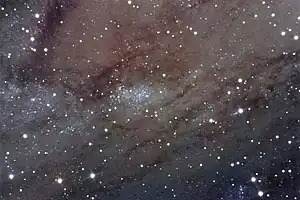| NGC 206 | |
|---|---|
 NGC 206 | |
| Observation data (J2000 epoch) | |
| Right ascension | 00h 40m 31.3s[1] |
| Declination | +40° 44′ 21″[1] |
| Apparent dimensions (V) | 4.2′ (arcmin) |
| Physical characteristics | |
| Radius | Ca. 400 ly |
| Associations | |
| Constellation | Andromeda |
NGC 206 is a bright star cloud in the Andromeda Galaxy, and the brightest star cloud in Andromeda when viewed from Earth.
Features
NGC 206 is the richest and most conspicuous star cloud in the Andromeda Galaxy, and is one of the largest and brightest star-forming regions in the Local Group.[2] It contains more than 300 stars brighter than Mb=−3.6.[3] It was originally identified by Edwin Hubble as a star cluster but today, due to its size, it is classified as an OB association.[4]
NGC 206 is located in a spiral arm of the Andromeda Galaxy, in a zone free of neutral hydrogen. It contains hundreds of stars of spectral types O and B. The star cloud has a double structure: one region has an age of around 10 million years and includes several H II regions in its border; the other region has an age of 40 to 50 million years and includes a number of cepheids. The two regions are separated by a band of interstellar dust.[5]
See also
References
- 1 2 "NASA/IPAC Extragalactic Database". Results for NGC 206. Retrieved 25 November 2006.
- ↑ Massey, Philip; Armandroff, Taft E.; Pyke, Randall; Patel, Kanan; Wilson, Christine D. (1995). "Hot, Luminous Stars in Selected Regions of NGC 6822, M31, and M33". Astronomical Journal. 110: 2715. Bibcode:1995AJ....110.2715M. doi:10.1086/117725.
- ↑ Hodge, Paul W. (1992). The Andromeda Galaxy. Springer. p. 153.
- ↑ Hodge, Paul W. (1992). The Andromeda Galaxy. Springer Science & Business Media. p. 20. ISBN 978-0-7923-1654-1.
- ↑ Chernin, Arthur D.; Efremov, Yury N.; Voinovich, Peter A. (1995). "Superassociations: violent star formation induced by shock-shock collisions". Monthly Notices of the Royal Astronomical Society. 275 (2): 313–326. Bibcode:1995MNRAS.275..313C. doi:10.1093/mnras/275.2.313.
.jpg.webp)